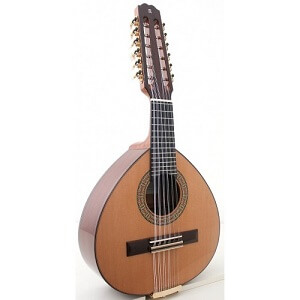Bandurria
 In Peru (and Bolivia) they use a kind of mandolin, which is called bandurria. Although its shape resembles somewhat the Spanish bandurria (with 6 double strings), it has in fact only 4 courses. Usually the courses are with double metal strings, but often with 3, 4 or even 5 strings per course, resulting in 8, 12, 16 or even 20 strings in total. On the slotted tuning head the machine tuners are equally divided on both sides.
In Peru (and Bolivia) they use a kind of mandolin, which is called bandurria. Although its shape resembles somewhat the Spanish bandurria (with 6 double strings), it has in fact only 4 courses. Usually the courses are with double metal strings, but often with 3, 4 or even 5 strings per course, resulting in 8, 12, 16 or even 20 strings in total. On the slotted tuning head the machine tuners are equally divided on both sides.
The body is constructed like a guitar, with a flat back. The strings are fastened to a guitar-like bridge, glued to the front.
Bandurria is a flat body musical instrument, pear-shaped, with a Neck and a Headplate with twelve strings (six pairs): of these six are made of gut and six are gimped, although modern Bandurria usually has the first two metallic pairs and gimped the last four pairs. Gimped strings may have the soul of steel or nylon.
Bandurria is used in choirs and popular music. Despite what is generally thought, it is also used to interpret academic music.
The bandurria, which is used in many styles of folk and popular music, was known in 16th-century Spain and traveled to Latin America; it is still used in Peru. It is known as the mandurria in the Balearic Islands of the Mediterranean Sea. A descendent of the bandurria is the bandola, a teardrop-shaped lute of Central and South America.